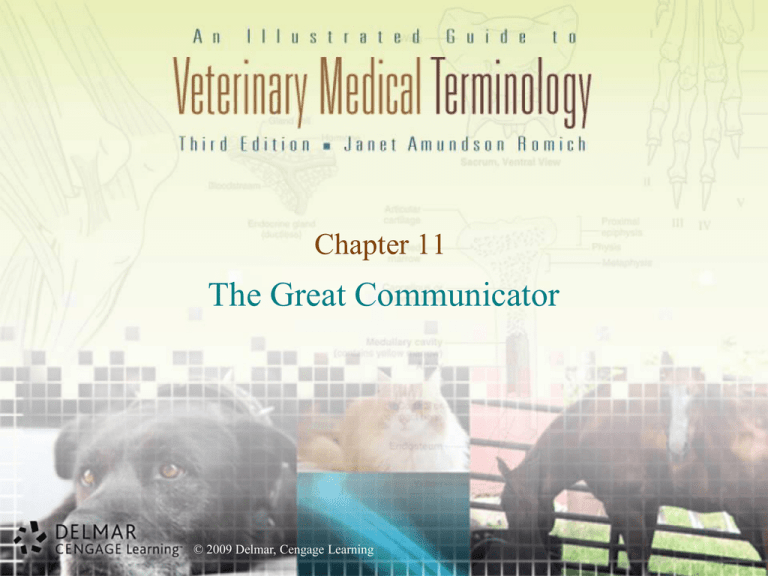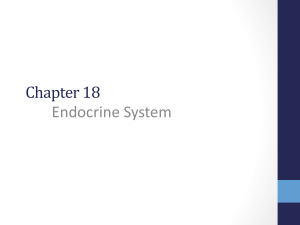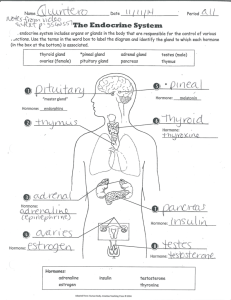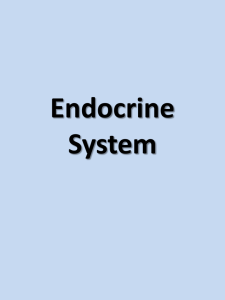File
advertisement

Chapter 11 The Great Communicator © 2009 Delmar, Cengage Learning Functions of the Endocrine System • The endocrine system is composed of ductless glands that secrete chemical messengers called hormones into the bloodstream. – Endo- means within. – -crine means to secrete or separate. © 2009 Delmar, Cengage Learning Functions of the Endocrine System • Hormones enter the bloodstream and are carried throughout the body to affect a variety of tissues and organs. © 2009 Delmar, Cengage Learning Structures of the Endocrine System • The glands of the normal endocrine system: – – – – – – – – one pituitary gland one thyroid gland four parathyroid glands two adrenal glands one pancreas one thymus one pineal gland two gonads © 2009 Delmar, Cengage Learning The Pituitary Gland • The pituitary gland is located at the base of the brain just below the hypothalamus. – The hypothalamus secretes releasing and inhibiting factors that affect the release of substances from the pituitary gland. – The combining form for the pituitary gland is pituit/o. – The pituitary gland has two lobes: anterior and posterior. © 2009 Delmar, Cengage Learning Pituitary Gland • Controls all other glands • Located within the sphenoid bone of the skull • Divided into 2 lobes – Anterior lobe – Posterior lobe © 2009 Delmar, Cengage Learning The Anterior Pituitary Gland • Secretions of the anterior pituitary gland: – – – – – thyroid stimulating hormone (TSH) adrenocorticotropic hormone (ACTH) follicle-stimulating hormone (FSH) luteinizing hormone (LH) interstitial cell-stimulating hormone (ICSH) – prolactin – growth hormone (GH) – melanocyte-stimulating hormone (MSH) © 2009 Delmar, Cengage Learning Anterior Lobe • Growth Hormone (Somatropin) • Thyroid Stimulating Hormone (TSH) • Gonadotropic Hormones – Ovaries • Follicle stimulating hormone (estrogen) • Luteinizing Hormone : formation of corpus luteum – Testes • Follicle stimulating hormone (development of sperm cells) • Luteinizing Hormone : testosterones • Prolactin (mammary gland development) © 2009 Delmar, Cengage Learning • Adrenocorticotropic Hormone (ACTH) – Adrenal glands – Production of corticosteriods • Melanocyte stimulating hormone (MSH) – melanin pigment in skin and hair – Involved in ability to undergo chameleonlike color changes © 2009 Delmar, Cengage Learning The Posterior Pituitary Gland • Secretions of the posterior pituitary gland: – antidiuretic hormone (ADH) – oxytocin © 2009 Delmar, Cengage Learning Posterior Lobe 1. Antidiuretic hormone (ADH) – Limits development of large volume of urine by reabsorbing water by kidneys 2. Oxytocin – Stimulates milk production and contraction of uterus during parturition © 2009 Delmar, Cengage Learning The Thyroid Gland • The thyroid gland is a butterfly-shaped gland that secretes the following: – triiodothyronine (T3) – thyroxine (T4) – calcitonin • The combining forms for the thyroid gland are thyr/o and thyroid/o. © 2009 Delmar, Cengage Learning Thyroid Gland • Regulates growth and metabolism • Over or under production of iodine • Calcitonin maintains balance of calcium in the blood by decreasing In birds causes molting and other behaviors linked to Changes in daylight. © 2009 Delmar, Cengage Learning January 7, 2015 • From memory • List the names of the glands belonging to the Endocrine System: 1. 2. 3. 4. 5. 6. 7. 8. © 2009 Delmar, Cengage Learning The Parathyroid Glands • The parathyroid glands are usually four glands located on the surface of the thyroid gland. • The parathyroid glands secrete parathormone. • The combining form for the parathyroid glands is parathyroid/o. © 2009 Delmar, Cengage Learning Parathyroid Gland • • • • “Near” thyroid gland / 2 on each side Parathyroid Hormone (PTH) Regulates calcium Maintains balance of calcium in blood by decreasing © 2009 Delmar, Cengage Learning The Adrenal Glands • The adrenal glands are two glands located cranial to each kidney; they consist of a cortex and a medulla. – Ad- means toward. – Ren/o means kidney. • The adrenal cortex secretes – mineralocorticoids – glucocorticoids – and androgens (sex hormones) • . © 2009 Delmar, Cengage Learning Adrenal Glands • The adrenal medulla secretes – epinephrine (adrenoline) – and norepinephrine • The combining forms for the adrenal glands are adren/o and adrenal/o. © 2009 Delmar, Cengage Learning The Pancreas • The pancreas is a gland located near the proximal duodenum that has exocrine and endocrine functions. • The endocrine functions of the pancreas maintain blood glucose levels. • The pancreas secretes insulin and glucagon. • The combining form for the pancreas is pancreat/o. © 2009 Delmar, Cengage Learning Pancreas • Insulin – Use and storage of carbohydrates (sugar) – Decrease blood glucose levels • Glucagon – Increase blood glucose levels © 2009 Delmar, Cengage Learning The Thymus • The thymus is a gland predominant in young animals located near midline in the cranioventral portion of the thoracic cavity. • The thymus secretes thymosin which is responsible for production of white blood cells (T- lymphocyte cells) / immunity • In adulthood becomes fatty piece of tissue © 2009 Delmar, Cengage Learning The Pineal Gland • The pineal gland is located near midline in the central portion of the brain and functions in maintaining circadian rhythm. • The pineal gland secretes melatonin. • Resemble pinecone • The combining form for the pineal gland is pineal/o. © 2009 Delmar, Cengage Learning The Gonads • The gonads are glands that produce gametes (sex cells). • The gonads are the ovaries in females and the testes in males. • The combining form for the gonads is gonad/o. © 2009 Delmar, Cengage Learning The Ovaries • The ovaries are the female gonads. • Secretions of the ovaries: – estrogen – progesterone • . © 2009 Delmar, Cengage Learning The Testes • The testes are the male gonads. • Secretion of the testes: – testosterone © 2009 Delmar, Cengage Learning Hyperadrenocorticism • Over production of glucocorticoid (hormone) • Commonly called Cushings Disease – An opposite disease is Addison’s where there is a deficiency Signs: Polydypsia Polyuria Body fat distribution © 2009 Delmar, Cengage Learning Pathological Conditions © 2009 Delmar, Cengage Learning Hyperthyroidism • • • • • Common in aging cats Excessive production of thyroid hormone Can feel an enlarged thyroid gland Can be treated with medication Surgical removal of the thyroid gland © 2009 Delmar, Cengage Learning Signs of Hyperthyroidism • • • • • • Weight loss (increased metabolism) Polyuria Polydipsia Meowing Aggression Affection • (Behavior changes) © 2009 Delmar, Cengage Learning Diabetes Mellitus • Insulin is hormone that transports blood glucose to be stored (as glycogen)and used for energy needs of cells • Pancreas doesn’t produce insulin, too much glucose in blood • Results in low pH of blood (acid) • Ketoacidosis = low blood pH and ketones (which are by products of fat metabolism) © 2009 Delmar, Cengage Learning • Ketoacidosis is result of no production of insulin = blood glucose (“sugar”) • Hypoglycemic is the opposite and is the result of overdose of insulin! © 2009 Delmar, Cengage Learning Things to remember about diabetes • Signs of diabetes: – – – – – – – – Often overweight Middle aged – senior Breed predisposition Cats Polydipsia Polyuria Sudden weight loss cataracts © 2009 Delmar, Cengage Learning Things to remember Diabetes can be treated but not cured: balancing between too much insulin and too little insulin – difficult for owners to understand initially – treatment is lifetime • Too much insulin can kill • Too little can result in death also © 2009 Delmar, Cengage Learning Medical Terms for the Endocrine System • Additional terms for endocrine system tests, pathology, and procedures can be found in the text. • Review StudyWARE to make sure you understand these terms. © 2009 Delmar, Cengage Learning








